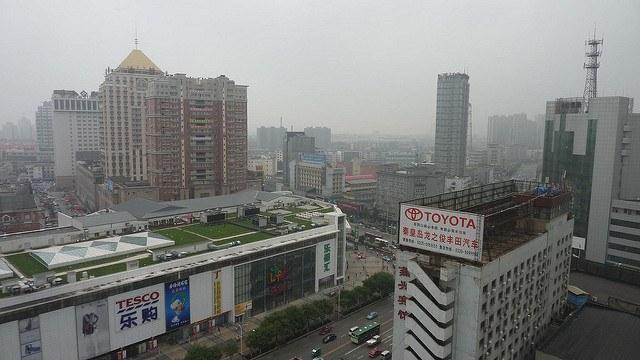
Last week in the Chinese coastal city of Qinhuangdao, 190 miles (300 kilometers) east of Beijing, a massive electric vehicle that appeared to be part-Transformer, part-Pokémon made its debut. The transit elevated bus (TEB), or “straddling bus,” embarked on a run just short of 1,000 feet (300 meters) at a top speed of 37 miles (60 km) per hour. This vehicle’s key selling point? It holds up to 1,400 passengers, runs on electric power and can hover over two lanes of traffic. Cars can drive through the TEB with plenty of clearance, meaning no interference to the daily commute.
The buzz over the TEB dominated China’s most popular social networking site, Weibo, as well as the international press from the New York Times to the BBC. Most writers described the TEB has a game-changer that could eventually disrupt public transportation. Engineers at the company that designed and built this floating bus touted its efficiency and cost-effectiveness. And of course, plenty of observers wondered what could happen in the event trucks, or cars with items such as bicycles atop their roofs, try to navigate the roads with these behemoths driving along with them.
Check out the Twitter pictures below to see what we're talking about, courtesy of China Xinhua News:
World's first transit elevated bus, TEB-1 on its launching test Tuesday in Qinhuangdao, N China's Hebei pic.twitter.com/yMepYWD1kD
— China Xinhua News (@XHNews) August 2, 2016
According to TEB Technology, the company that designed this vehicle, straddling buses offer several advantages. The vehicle has an electricity-powered drive train, and can recharge at each stop in order to have enough power to get from destination to destination during its daily route. Running on rails, up to four TEB vehicles can be connected in order to haul passengers on China’s congested streets. On roads wider than two lanes, larger vehicles such as trucks and vans can continue to drive in parallel with the TEB.
In cities using 40 of these vehicles to travel on round-trip routes 25 miles (40 km) long, 400,000 passengers could be transported daily, reducing traffic congestion by up to 35 percent, says TEB Technology, the company behind the bus. The cost savings for municipalities would be significant as well, as TEB Technology insists that cities adopting these straddling buses could do so at a cost far lower than building elevated trains or digging under the earth to build a subway system.
It is easy to see where such a vehicle would work. Yonge Street in Toronto, 9 de Julio in Buenos Aires, and Wilshire Avenue in Los Angeles are just a few examples of where the straddling bus could seamlessly transfer commuters from residential areas to business centers. Nevertheless, this technology has a long road ahead. The Qinhuangdao test run, it must be noted, was in a highly controlled environment. How would this TEB perform in everyday traffic, where distracted drivers, road rage and tired truck drivers could result in even more mayhem?
And the straddling buses still need infrastructure: Long tracks of rail would still need to be installed, and the typical bus shelter with a bench is not going to suffice for these massive vehicles. Navigating turns in these buses would also appear to ensnare traffic even more instead of helping it flow smoothly. Traffic authorities would have to ban trucks and perhaps even vans of a certain size from streets on which these huge bus/train hybrids run. But as municipalities seek to design the smart cities necessary in order to sustain urbanization trends this century, the feasibility of these straddling buses in an option worth studying.
Image credit: Flickr/Bill Bensen

Leon Kaye has written for 3p since 2010 and become executive editor in 2018. His previous work includes writing for the Guardian as well as other online and print publications. In addition, he's worked in sales executive roles within technology and financial research companies, as well as for a public relations firm, for which he consulted with one of the globe’s leading sustainability initiatives. Currently living in Central California, he’s traveled to 70-plus countries and has lived and worked in South Korea, the United Arab Emirates and Uruguay.
Leon’s an alum of Fresno State, the University of Maryland, Baltimore County and the University of Southern California's Marshall Business School. He enjoys traveling abroad as well as exploring California’s Central Coast and the Sierra Nevadas.














